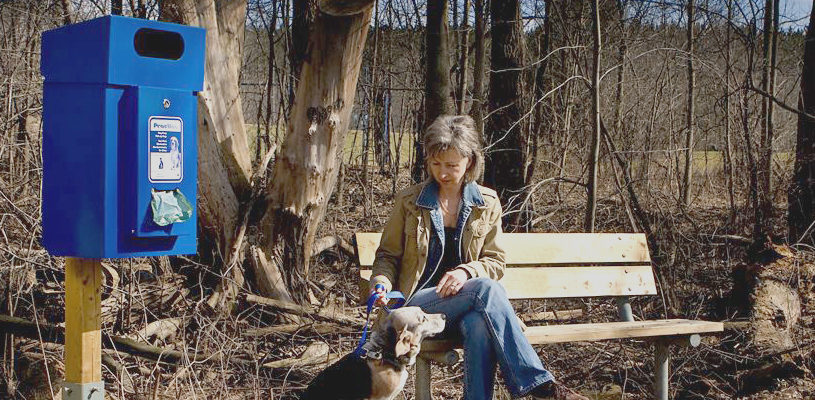Dog Waste Dilemma - examining the problem and determining the solution

Over the last decade, dog populations have been growing, especially in urban areas. As a result, dog waste has become a huge problem for municipalities, landfills, and park users. Exacerbating the problem is a common misconception that dog waste is “natural” – and therefore not harmful to the environment. But, the composition of dog waste is much different than that of other animals.
Health Risks and Environmental Impacts
Due to dogs’ stomach enzymes and diets, their waste is different from that of wild animals, containing incredibly high concentrations of nitrogen and phosphorus. This waste is also packed with very high levels of bacteria (such as E. coli, viruses, and parasites) that linger in the soil for years. As a result, dog waste pollutes watersheds, poses health risks to humans, spreads diseases and parasites to other dogs, and presents several other problems for municipalities. In small numbers, these threats would be minimal; but, we are not talking about small numbers. On average, one dog produces approximately one kilogram of waste every three days; and, according to the Canadian Animal Health Institute, the dog population in Canada is approximately 7.6 million dogs (as of 2016). Nationally, that translates to over 2.5 million kilograms of dog waste per day, and over 924 million kilograms per year. With that amount of waste, it’s no wonder that dog waste is considered a leading cause of pollution in urban watersheds. Studies have shown that as much as 30 percent of all bacteria in urban watersheds can be traced back to dog waste.
Beyond the health risks and watershed contamination, dog waste presents several problems for municipalities, including overuse of landfills, contamination of recycling bins, and ballooning labour costs in parks. Hundreds of millions of kilograms of dog waste is finding its way into the garbage bins of municipal parks. In fact, municipal park waste audits in different cities report that between 40 and 80 percent of waste in park garbage containers is dog waste. Worse yet, some cities report that as much as 97 percent of their recycling containers are contaminated by pet waste, with all of that potentially recyclable material then destined for the landfill.
Segregating and diverting dog waste to anaerobic bio-digesters is a way to turn that waste into a resource. When dog waste is processed through an anaerobic bio-digester, it creates biogas, which is used to generate power. The City of Waterloo has already begun doing this and has seen great success so far. The idea seems to be catching on, too, as anaerobic digestion facilities are being built in several places across Canada, including the City of Edmonton (which is scheduled to open a brand new, state of the art facility in 2018).
Meeting the Challenges
While dog waste is clearly a large and challenging problem across the country, a little planning now can lead to some big benefits down the road.
The first challenge involved is keeping dog waste off the ground. Some people forget to bring bags, others don’t bring enough bags, and some simply aren’t aware of how dog waste harms the environment. Combined with public awareness campaigns, pick-up bag dispenser programs have been tremendously successful in increasing pick-up compliance. By having bags available in public dispensers, dog owners no longer have an excuse; and, when combined with public education, such initiatives can encourage a culture of responsible ownership throughout the community.
For example, Winnipeg’s Kilcona Dog Park Club conducted a year-long trial program to evaluate the effectiveness of pick-up bag dispensers. The study “concluded that the bag dispensers were responsible for a demonstrated improvement in park cleanliness, and that the bag dispensers were well worth the cost and effort to maintain them.” This success is commonplace across Canada. (Practica Ltd. has been a supplier of pick-up bag dispensers and bags since 2000, and now serves over 400 municipalities from Halifax to Yellowknife.) Corporate sponsorship and licence fees can be a way to help cover the costs of bag dispenser programs, while local dog park groups can help with maintenance.
 The second challenge is dealing with the waste after it’s been picked up. In municipal parks, regular waste bins are often overflowing with dog waste, creating several problems, not the least of which is odour issues. Bins fill up very quickly, requiring staff to empty the heavy bins far more often than necessary; recycling containers end up getting contaminated; and all of the waste ends up bound for landfills that either don’t want it or don’t have room for it. To help address this issue, Practica Ltd. recently partnered with Sutera to distribute the in-ground dog waste containment system. The in-ground bin provides a specific place for park users to deposit their used pick-up bags. The top of the unit is specially designed so that other waste, such as coffee cups, will not fit in the chute. As a result, the large underground catch basin fills with dog waste, which can then be emptied by a vacuum or vertical lift truck, and be hauled to a facility capable of properly dealing with the waste.
The second challenge is dealing with the waste after it’s been picked up. In municipal parks, regular waste bins are often overflowing with dog waste, creating several problems, not the least of which is odour issues. Bins fill up very quickly, requiring staff to empty the heavy bins far more often than necessary; recycling containers end up getting contaminated; and all of the waste ends up bound for landfills that either don’t want it or don’t have room for it. To help address this issue, Practica Ltd. recently partnered with Sutera to distribute the in-ground dog waste containment system. The in-ground bin provides a specific place for park users to deposit their used pick-up bags. The top of the unit is specially designed so that other waste, such as coffee cups, will not fit in the chute. As a result, the large underground catch basin fills with dog waste, which can then be emptied by a vacuum or vertical lift truck, and be hauled to a facility capable of properly dealing with the waste.
Because the unit stores waste in cool conditions (underground), is out of the sunlight, and has only a small opening at the top, virtually no odour escapes. Its large capacity is a huge benefit when it comes to service frequency, saving the time – and the backs – of municipal park staff. The in-ground unit takes six to eight weeks to fill and contains approximately 500 kilograms of dog waste. A worker restricted to lifting 50 pounds (approximately 22.5 kilograms), would need to make 22 trips and lift 22 bags of dog waste from the regular containers to move the equivalent amount of waste. Instead, that waste can all be hauled mechanically in a single trip. But, most importantly, there is a significant reduction in the contamination of recycling containers, and all of the dog waste is diverted from landfill to create hydro – instead of waste.
Creativity and Partnerships
With a little creativity and partnerships within the community, municipalities can generate the required funding for dog waste management programs. By sponsoring ads on dispensers, for example, local businesses have an opportunity to contribute to the community, while also ingratiating themselves to local dog owners. In addition, adding a small dollar amount to dog licence fees may bring in thousands – if not tens of thousands – of dollars every year. Combining these two methods has the potential to generate a significant amount of funding – possibly even positive revenue.
While dog waste is a large and growing problem for municipalities across Canada, there are now solutions and opportunities to make a big impact.
Dan Tully is a Sales Representative for Practica Ltd., a dog waste disposal solutions provider in Cambridge, ON.
as published in Municipal World, March 2018



